Sensory light tables have become an essential tool in modern preschool classrooms, offering endless opportunities for hands-on learning and development. According to the National Association for the Education of Young Children (NAEYC), sensory play is crucial for brain development and helps children process and respond to sensory information. As educational institutions seek innovative ways to engage children in meaningful sensory experiences, the sensory light table stands out as a versatile investment that supports multiple learning objectives simultaneously.
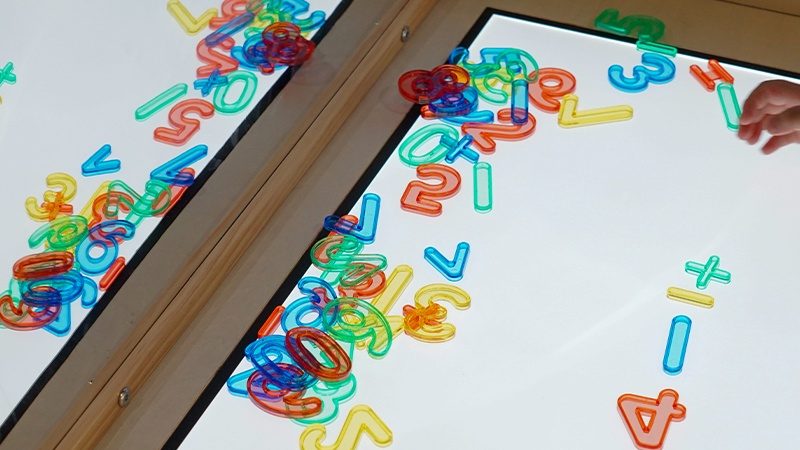
Table of Contents
- What is a Sensory Light Table?
- Why Sensory Light Tables Are Essential for Preschool Classrooms
- Age-Appropriate Activities and Materials
- 25+ Engaging Activities for Your Light Table Sensory Center
- Essential Materials for Your Lighted Sensory Table
- Cost-Effective DIY Options for Budget-Conscious Institutions
- Classroom Setup and Management Tips
- Choosing the Right Light Sensory Table for Your Institution
- Safety Considerations and Best Practices
What is a Sensory Light Table?
A sensory light table is a specialized educational tool featuring a translucent surface illuminated from below, creating an engaging platform for hands-on exploration. Research from the Harvard Graduate School of Education demonstrates that hands-on learning experiences significantly enhance cognitive development in young children. These lighted sensory tables transform ordinary materials into extraordinary learning experiences by adding the element of light, which naturally captivates children’s attention and enhances sensory input.
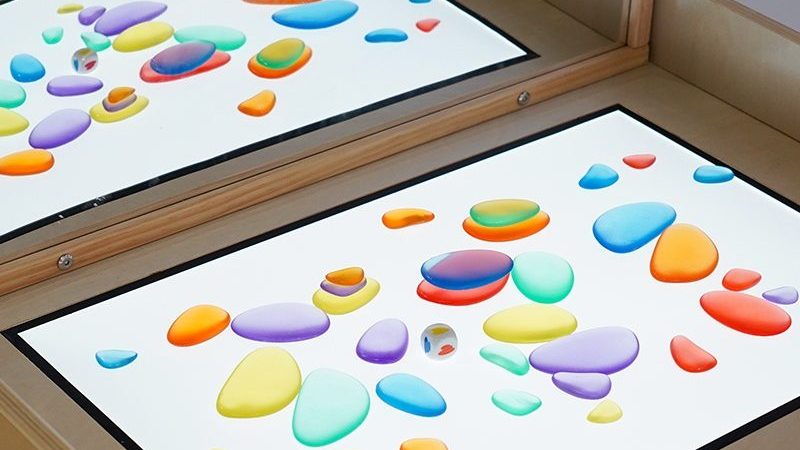
Unlike traditional play tables, a light table sensory setup creates:
- Enhanced visual contrast that makes materials more engaging
- Opportunities to explore transparency, opacity, and color mixing
- A naturally calming environment that promotes focus
- Multi-sensory experiences that support various learning styles
For institutions looking to invest in quality educational equipment, our Light Play Table offers professional-grade construction designed specifically for classroom environments.
Why Sensory Light Tables Are Essential for Preschool Classrooms
Developmental Benefits Backed by Educator Experience
The American Academy of Pediatrics emphasizes that sensory play is fundamental to healthy child development. Research published in Early Childhood Education Journal shows that multi-sensory learning environments significantly improve retention and engagement in preschool children. Based on feedback from early childhood educators and classroom observations, sensory light tables provide:
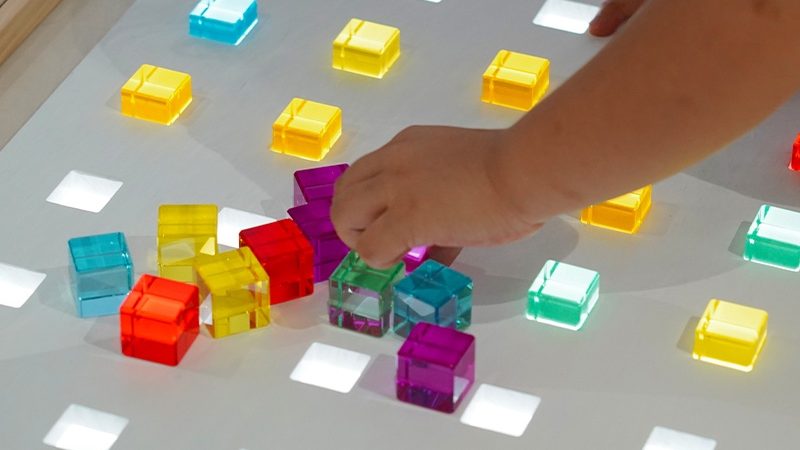
Cognitive Development:
- Pattern Recognition: Children naturally create and identify patterns when arranging translucent materials
- Classification Skills: Sorting activities become more engaging with illuminated materials
- Cause-and-Effect Learning: Immediate visual feedback when manipulating objects on the light surface
- Early STEM Concepts: Natural introduction to light, shadow, and color theory
Fine Motor Skills Enhancement:
- Precise manipulation of small objects like Magnatiles and colored gems
- Improved hand-eye coordination through tracing activities
- Strengthened pincer grasp through sorting and arranging tasks
According to Scholastic’s Early Childhood Development resources, activities that require precise hand movements are crucial for pre-writing skill development.
Sensory Integration:
- Visual processing skills through light and color exploration
- Tactile experiences combined with visual stimulation
- Calming sensory input that helps regulate emotions
Social-Emotional Learning:
- Collaborative play opportunities at shared light sensory tables
- Stress reduction through focused, meditative activities
- Confidence building through open-ended exploration
Age-Appropriate Activities and Materials
Toddlers (12-24 months)
Supervision Level: High
- Simple cause-and-effect with large translucent objects
- Sensory exploration with water beads (supervised)
- Large colored shapes for grasping and moving
Preschoolers (2-3 years)
Supervision Level: Moderate
- Color sorting with translucent materials
- Simple pattern creation
- Sand and rice exploration (contained)
Pre-K (3-5 years)
Supervision Level: Minimal
- Complex pattern and design creation
- Tracing and pre-writing activities
- Collaborative building with Magnatiles
- Shadow puppet creation
25+ Engaging Activities for Your Light Table Sensory Center
Visual Arts and Creativity
- Translucent Painting: Use translucent paints and clear surfaces for layered art
- Color Mixing Exploration: Layer colored transparencies to discover new colors
- Shadow Art: Create art using shadows of various objects
- Tracing Practice: Use markers and tracing paper for pre-writing skills
- Collage Creation: Arrange colored cellophane and transparent materials
STEM Learning
- Light and Shadow Science: Explore how different materials affect light
- Magnatile Architecture: Build structures while exploring light transmission
- Color Theory Investigation: Layer primary colors to create secondary colors
- Shape Recognition: Sort and identify geometric shapes on illuminated surface
- Pattern Sequencing: Create and extend patterns with colorful materials
According to research from the Fred Rogers Institute, hands-on exploration activities like these are essential for developing scientific thinking skills in young children.
Sensory Exploration
- Water Bead Discovery: Explore texture and light refraction (supervised)
- Rice and Grain Play: Create textures and patterns with illuminated grains
- Liquid Sensory Bags: Sealed bags with colored liquids for safe exploration
- Textured Material Investigation: Compare smooth, rough, and bumpy surfaces
- Temperature Exploration: Safe warm/cool materials on light surface
Language and Literacy
- Story Creation: Use translucent figures to act out stories
- Letter Formation: Trace letters using finger paints or markers
- X-ray Exploration: Examine X-rays while discussing body parts
- Color Vocabulary: Describe colors, shades, and transparency levels
- Descriptive Language: Articulate textures, patterns, and visual effects
Fine Motor Development
- Precision Sorting: Use tweezers to sort small translucent objects
- Bead Threading: String translucent beads while backlit
- Cutting Practice: Cut colored transparencies along lines
- Puzzle Assembly: Complete translucent puzzles on light table
- Tool Usage: Use various tools to manipulate materials
Essential Materials for Your Lighted Sensory Table
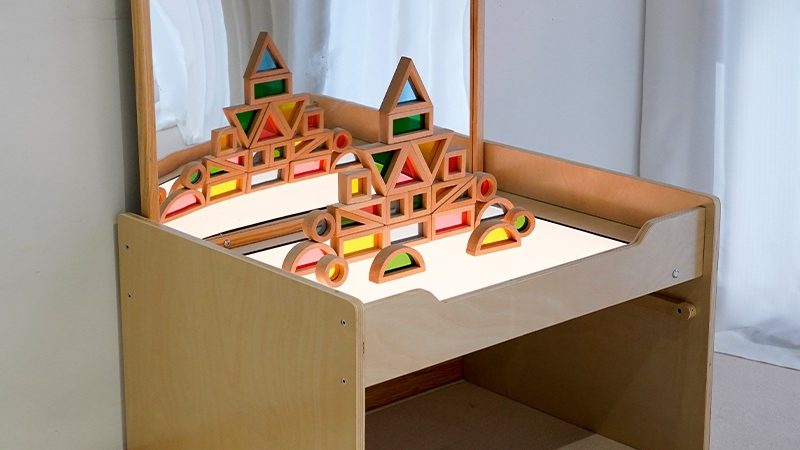
The Center for Early Childhood Education at Eastern Connecticut State University recommends using a variety of materials to maximize sensory learning experiences. Our complete Light Shadow Sensory Series provides comprehensive solutions for creating engaging sensory learning environments.
Must-Have Translucent Materials
- Magnatiles: “We have the Magnatiles in our light centers and the kids love them” – ECE Professional
- Colored transparencies: Cut from binder dividers for sorting activities
- Water beads: Provide mesmerizing visual effects (supervision required)
- Translucent blocks and shapes: Various sizes for building and sorting
- Colored gems and stones: Natural and artificial options
Sensory Materials
Research from Zero to Three: National Center for Infants, Toddlers, and Families shows that varied sensory experiences are crucial for brain development in early years.
- Rice (uncooked): Creates interesting textures and patterns
- Colored sand: Safe, contained sensory exploration
- Liquid-filled sensory bags: Mess-free exploration options
- Textured transparencies: Add tactile elements to visual exploration
Art and Writing Materials
- Washable markers: For tracing and art creation
- Tracing paper: Essential for pre-writing activities
- Colored cellophane: Layering and color-mixing activities
- Transparent paint: Specially formulated for light table use
Educational Tools
- X-rays: Real or educational replicas for science exploration
- Colored filters: Photography gels for advanced color exploration
- Magnifying glasses: Enhance observation skills
- Rulers and measuring tools: Introduce early math concepts
Cost-Effective DIY Options for Budget-Conscious Institutions
Simple Storage Container Light Table
Materials Needed:
- Large clear plastic under-bed storage container
- Rope lights or LED strip lights
- Frosted contact paper or white fabric
Assembly:
- Place lights evenly around the bottom of container
- Cover lights with frosted surface for even illumination
- Ensure all electrical connections are secure and child-safe
Tablet-Style Light Box Alternative
For Individual Use:
- Large LED tracing tablet
- Portable and easy to store
- Perfect for small group activities
- Can be used on any flat surface
Classroom Setup and Management Tips
Space Considerations
- Location: Position near natural light sources but avoid direct sunlight
- Accessibility: Ensure wheelchair and mobility device access
- Storage: Plan for easy material storage and organization
- Seating: Provide appropriate seating options for extended use
Material Organization
- Use clear, labeled containers for easy material identification
- Rotate materials weekly to maintain interest and novelty
- Create material-specific activity cards for independent exploration
- Establish clear cleanup procedures with visual supports
Student Management
- Small Groups: Limit to 2-4 children for optimal engagement
- Time Limits: 15-20 minute sessions prevent overstimulation
- Clear Expectations: Establish rules for sharing and material care
- Documentation: Photograph children’s creations for portfolios
Choosing the Right Light Sensory Table for Your Institution
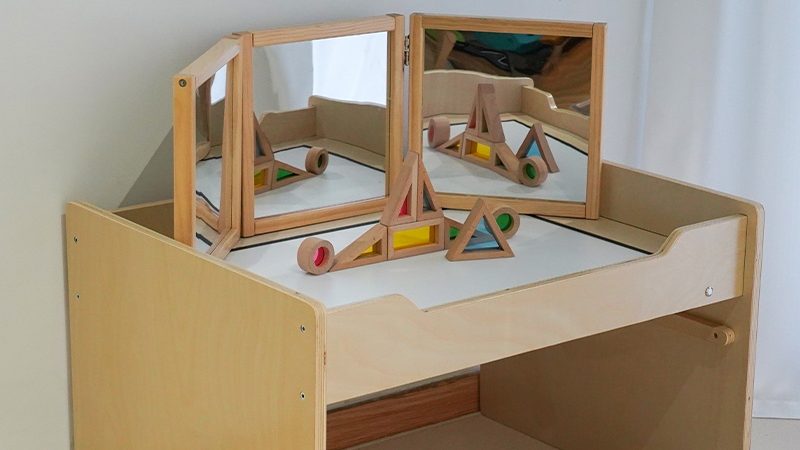
Essential Features for Educational Settings
The National Association for Family Child Care recommends investing in durable, safe educational equipment that can withstand daily classroom use. When selecting a sensory light table for your institution, consider these professional-grade features:
Durability Requirements:
- Commercial-grade construction for daily classroom use
- Easy-to-clean surfaces that withstand sanitization
- Stable base that won’t tip with active use
- Scratch-resistant illuminated surface
Size Considerations: According to guidelines from Teaching Strategies, optimal learning occurs when children have adequate space for exploration without overcrowding.
Power and Safety Features:
- Low-voltage LED lighting for child safety
- Cool-operating lights to prevent burns
- Easy-access power controls for educators
- Cord management systems for trip prevention
Versatility Options: Our Light Play Table incorporates all these essential features while offering:
- Removable surface for easy cleaning
- Energy-efficient LED lighting
- Storage options for materials and supplies
Safety Considerations and Best Practices
Electrical Safety
- Regular inspection of all electrical components
- Use only manufacturer-approved replacement parts
- Ensure proper grounding and electrical certification
- Train all staff on safe operation procedures
Material Safety
- Choose age-appropriate materials for each group
- Regularly inspect materials for damage or wear
- Establish clear guidelines for material use
- Maintain current safety data sheets for all materials
Supervision Guidelines
- Always supervise children under 3 years old
- Establish clear sight lines to light table area
- Train staff to recognize overstimulation signs
- Create intervention strategies for conflicts
Health and Hygiene
- Daily cleaning protocols for all surfaces
- Sanitization procedures between student groups
- Individual material sets when possible
- Regular deep cleaning schedules
Maximizing Your Investment: Long-Term Benefits
Educational ROI
- Supports multiple curriculum areas simultaneously
- Appeals to various learning styles and preferences
- Provides documentation opportunities for assessment
- Encourages parent engagement through shared experiences
Professional Development Opportunities
- Staff training in sensory learning approaches
- Collaboration with occupational therapy professionals
- Integration with existing curriculum frameworks
- Research and documentation projects
Conclusion: Illuminating Learning Possibilities
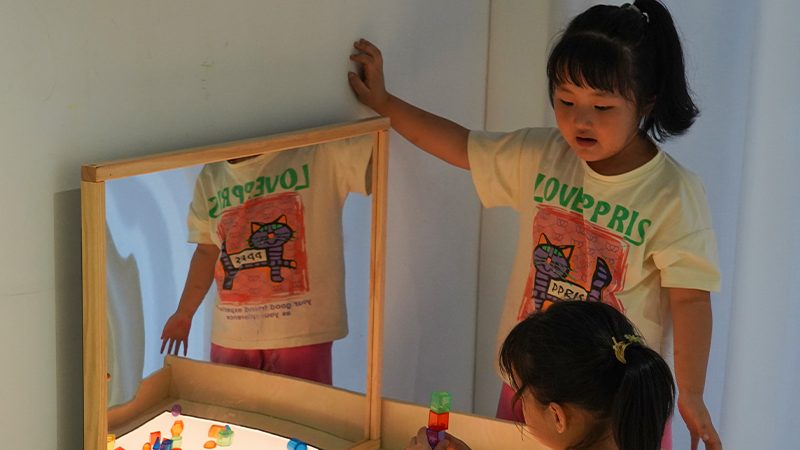
The sensory light table represents more than just another piece of classroom equipment—it’s a gateway to multi-sensory learning experiences that support crucial developmental milestones. Research from the Child Development Institute confirms that sensory-rich environments significantly enhance learning outcomes in early childhood education. From enhancing fine motor skills in toddlers to fostering creativity and scientific thinking in preschoolers, these versatile tools offer exceptional value for educational institutions.
By thoughtfully selecting materials, establishing clear procedures, and maintaining focus on developmental goals, your light table sensory center will become a cornerstone of your early childhood program. Whether you choose our professional-grade Light Play Table or explore our complete Light Shadow Sensory Series, the key lies in consistent, intentional use that supports your educational objectives.
Ready to illuminate your students’ learning journey? Consider starting with a quality setup and gradually expanding as you observe children’s interests and developmental needs. The investment in a professional light sensory table will pay dividends in engaged learning, enhanced development, and joyful discovery for years to come.